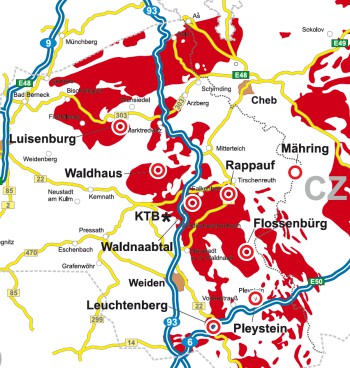
Standort 5: Tirschenreuth Grube Rappauf
Verwitterter Granit – Kaolin für die Porzellanindustrie
Ein wesentlicher Rohstoff zur Herstellung von Porzellan ist das Tonmineral
Kaolinit. Es ist ein weißliches Tonmineral und entsteht durch die
Verwitterung von Feldspat, dem Hauptmineral des Granits.

Kaolin pro porcelánový průmysl
Podstatnou surovinou pro výrobu procelánu je jílový minerál kaolinit. Ten je odpovědbý ta jeho bílou barvu a vzniká zvětráním živce, hlavního minerálu hlubinné horniniy žuly.

Kaolin for the porcelain industry
The major raw material for the production of porcelain is the clay mineral kaolinite. This is white in colour and is a weathering product of feldspar, the most common mineral in granite.
Bildimpressionen

Tafelstandort in der Karte

Klicken Sie auf den Ortsnamen für mehr Informationen
Tafel 1: Leuchtenberg
Vom Magma zum FestgesteinOd magmatu k pevné hornině
From magma to solid granite
Tafel 2: Pleystein
Granit-Pegmatit – das Beste zum SchlussŽulový pegmatit
Granite pegmatite
Tafel 3: Flossenbürg
Naturwerkstein GranitDekorační kámen žula
Granite as a natural stone
Tafel 4: Mähring
Strahlender Granit – Radioaktivität im SteinZářící žula – radioaktivita v kameni
Radiating granite – radioactivity of the rock
Tafel 5: Grube Rappauf Tirschenreuth
Verwitterter Granit – Kaolin für die PorzellanindustrieKaolin pro porcelánový průmysl
Kaolin for the porcelain industry
Tafel 6: Waldnaabtal
Landschaftsformen im GranitŽulové krajinné útvary
Landscape shaped in granite
Tafel 7: Waldhaus Pfaben
Boden aus Granit – Bedeutung für den WaldPůdy na žule – význam pro les
Soil from granite – significance for the forest
Tafel 8: Wunsiedel Luisenburg
Verwitterungsformen im Granit – Felstürme, Wollsäcke und BlockmeereZvětrávací tvary žuly
Weathering of granite



